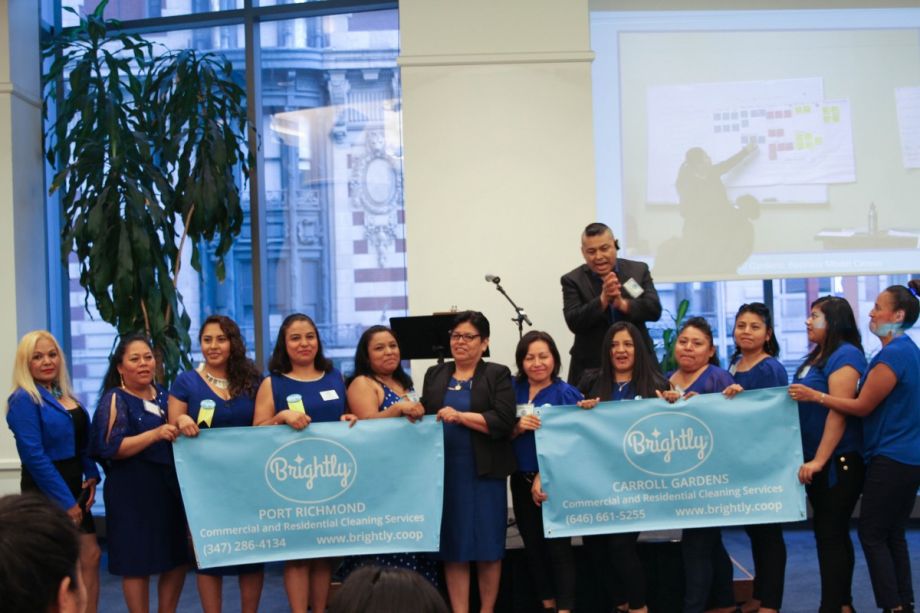On a typical day, Araceli Dominguez, 41, wakes up at 6 a.m., and makes lunches for her two daughters, her husband, and herself. Then she departs from her Staten Island home for work, cleaning homes and offices in other parts of the city. It takes an hour and a half to get to her usual first daily client, taking public transit across the Verrazano-Narrows Bridge to Brooklyn. She wraps up her day at office clients in Manhattan, after normal business hours, often finishing up around 11 p.m. Then it’s time for a leisurely ride home on the Staten Island Ferry, past the Statue of Liberty. She usually gets home around midnight.
Dominguez has worked in the cleaning industry since 2007. Her days may still be long, but for the past two years, she’s earned at least twice per hour what she’s made before, and if she has had to take off work to be part of her daughter’s lives or attend an important business meeting, she hasn’t had to worry about her boss saying no. As a member of a worker-owned cleaning cooperative based on Staten Island, she doesn’t have a boss. And now, Dominguez is part of the leadership team that is helping expand this same kind of opportunity to workers across the country, starting here in New York City.
Dominguez’s co-op is one of the founding members of the Brightly Cleaning Co-Op franchise network, thought to be the first worker cooperative franchise network in the country. The idea is to take a page out of corporate America’s playbook and put it into service of workers. The same way that conventional franchising has allowed millions of entrepreneurs get their own business started more easily than if they started from scratch, the Brightly Franchise network will offer workers the chance to do the same, only in a worker cooperative setting intended to insure better pay and fair working conditions. Dominguez, who was also the founding treasurer of her co-op, now serves on the governing board of the franchise network.
“[Being our co-op’s founding treasurer] was a really tremendous opportunity to learn, and once I became comfortable knowing I could do it, I thought it was time to turn around and teach others,” Dominguez says, through an interpreter.
Despite mostly being known today for massive corporate profits fueled by low wages and poor working conditions, the franchise model has social roots. Martha Matilda Harper’s beauty salon network was the first true franchise, with ultimately over 500 locations and clients such as Susan B. Anthony, Woodrow Wilson, Calvin and Grace Coolidge, Jacqueline Kennedy and Helen Hayes. Harper pushed for economic opportunity for underprivileged women (she dictated that the first 100 Harper’s franchises would be opened by poor women) in an era when most women’s options were limited.
Bringing franchises back to this ideal is taking some time. Spring Impact (formerly the International Social Franchising Network) has been working since 2011 to support those with business models addressing social problems to scale up those models through franchising.
The idea for a worker co-op franchise network goes back a few years at the Center for Family Life, a nonprofit based in the Sunset Park section of Brooklyn, which has been incubating worker cooperatives for more than a decade. Some of their successes include Sí Se Puede, a cleaning cooperative founded in 2006, now with more than a hundred members; and Green Magic LLC, a cleaning cooperative based in Newark, N.J.
“The team realized co-ops were successful, a great way to improve wages and conditions for workers, but the challenges facing startups are still formidable, both to enter the market and to find clients when you’re ready t0 launch the business,” says Phyllis Robinson, whom the Center for Family life hired to coordinate the franchise network.
The challenges to start a franchise network also turned out to be formidable. The Center for Family life worked with lawyers from a nationally known franchising law firm to start with a typical franchise agreement, more than 200 pages long, and revise it to make sense for a worker-owned and operated business. Each of the founding member co-ops — Dominguez’s in Staten Island and another in Brooklyn — had their own lawyers as well. It was six months of back-and-forth. Grant funding for the center’s lawyers came from the Staten Island Foundation.
“What we’re trying to do is take what a conventional franchise offers — it’s a growing sector of small businesses in the country for a reason — and … make it work for workers,” Robinson says.
One issue was the franchise fee, which business owners pay up front to buy a license to operate a franchise location, usually covering a specific geographic area. These fees are typically between $20,000-$50,000. The Brightly fee is $0.
Another issue was the non-compete clause. Franchisors (the parent company that owns the franchise) typically require franchisees to agree not to enter the same business in the same geographic area for a certain period of time after they leave the franchise network. It’s a sensible idea — the franchisor doesn’t want the entrepreneur to just learn the business and then leave the franchise and do their own thing without having to pay monthly royalties back to the franchisor.
But that kind of non-compete clause didn’t quite work for a worker-friendly franchise model, Robinson says. The point of the franchise isn’t to limit opportunity for workers, but to make it easier for them to find or create better opportunities for themselves or for each other. So instead, if a worker decides to leave a Brightly co-op, they can clean houses independently, work for another worker cooperative, create a whole new co-op, or they could even work for a conventional franchise cleaning service like Molly Maid.
“The only thing you cannot do if you leave Brightly before the franchise agreement is over is start a conventional cleaning company and hire employees,” Robinson says. “What we want you to do is use this experience to continue gaining employment or to spread the co-op model, we just don’t want you to become part of the capitalist system and exploit others.”
Some issues were much simpler to resolve, like a clause requiring employees to carry vehicle insurance — potentially prohibitive, and totally irrelevant for Brightly members in transit-rich New York City.
There are royalty fees. Brightly franchise co-ops pay five percent of their monthly revenues to support shared back-office employees including two office managers and Robinson, currently on staff at the Center for Family Life.
The back-office staff serve as an answering service for clients and managing scheduling. Robinson says the idea is for each client across the network to have the same seamless, reliable experience. As more Brightly co-ops come online,the nonprofit expects that the back-office staff will become self-sustaining within ten years. In addition to the two current Brightly co-ops, a third is expected to launch in August, based in East Harlem.
There are still some start-up costs for workers. According to the Center for Family Life, cleaning cooperatives they’ve supported usually need to fundraise between $1,500-$2,500, which allows them to pay for incorporation fees, one year of insurance and some marketing costs for co-op tee shirts and advertising postcards. One of the Brightly co-ops also had Brightly-branded tote bags made for themselves. Each co-op is responsible for its own marketing, and it’s still done mostly through word-of-mouth. But so far, Brightly co-op revenues were 20 times higher after one year of business than comparable cleaning cooperatives starting up without a franchise, according to Maru Bautista, director of the cooperative development program at the Center for Family Life.
In Staten Island, Dominguez’s Brightly co-op currently has seven members serving anywhere from 80-100 clients a month. That’s just about their full capacity at the moment, Dominguez says. If they wanted to take on more, they’d have to hold an open house to recruit new members.
As the network grows and questions inevitably arise around which co-ops are responsible for which areas of the city or how to deal with problematic clients, those questions will fall to Brightly’s industry committee, with representatives from each of the co-ops, which meets monthly.
Meanwhile, Brightly’s governing board is charged with expanding the network around New York City and beyond. Brightly worked with a few University of Pennsylvania graduate students on a feasibility study looking at market conditions, transportation systems, friendliness to immigrants, wages and competition in Philadelphia; Newark, N.J.; and New Rochelle, N.Y. Robinson hopes at least one of those cities will have a Brightly co-op franchise up and running by the end of next year. They’ll work through the same model the Center for Family Life has used in Brooklyn, with local community organizers coming to them with women interested in starting a worker cooperative.
Robinson says the nonprofit hopes to bring the worker cooperative franchise model to other sectors as well, perhaps elder care, nanny services, or even dog walking.
As more cooperatives emerge, through Brightly or otherwise, Robinson hopes scale can help address what are currently some big holes in the worker co-op model: health insurance and retirement savings, both of which work better at larger scale.
Then of course there are the problems that every small business faces, like big clients being slow to pay up. Dominguez says commercial clients on large contracts are typically slower to pay. One client took almost five months to start paying, but that was apparently a new client miscommunication, and they’ve paid on time ever since.
This article is part of The Bottom Line, a series exploring scalable solutions for problems related to affordability, inclusive economic growth and access to capital. Click here to subscribe to our Bottom Line newsletter.

Oscar is Next City's senior economic justice correspondent. He previously served as Next City’s editor from 2018-2019, and was a Next City Equitable Cities Fellow from 2015-2016. Since 2011, Oscar has covered community development finance, community banking, impact investing, economic development, housing and more for media outlets such as Shelterforce, B Magazine, Impact Alpha and Fast Company.
Follow Oscar .(JavaScript must be enabled to view this email address)


















